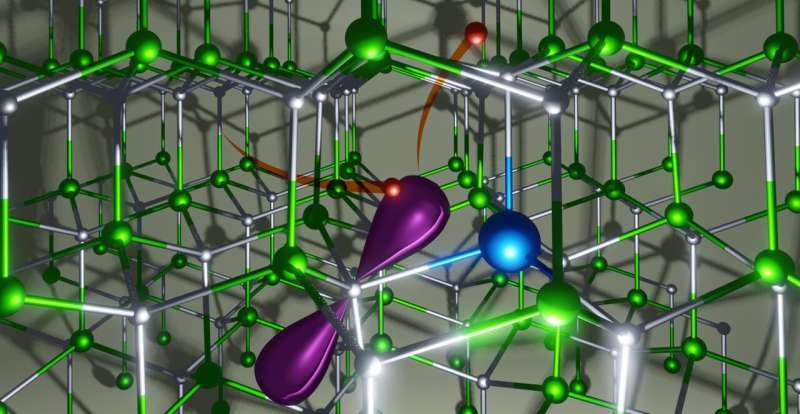
Defects often impose limitations on the performance of devices, such as light-emitting diodes (LEDs). While the mechanisms behind the annihilation of charge carriers by defects are well understood in materials emitting red or green light, the loss in shorter-wavelength (blue or ultraviolet) emitters has lacked an explanation.
A recent study conducted by researchers in the Department of Materials at UC Santa Barbara has shed light on the crucial role played by the Auger-Meitner effect. This mechanism allows an electron to lose energy by transferring it to another electron in a higher-energy state.
According to Materials Professor Chris Van de Walle, whose group conducted the research, “It is well known that defects or impurities, collectively referred to as ‘traps,’ reduce the efficiency of LEDs and other electronic devices.”
Using a new methodology, the researchers discovered that the trap-assisted Auger-Meitner effect can result in loss rates that are significantly higher than those caused by previously considered mechanisms. This resolves the mystery surrounding the impact of defects on the efficiency of blue or UV light emitters. The findings have been published in the journal Physical Review Letters.
The detrimental effects of this phenomenon were observed as far back as the 1950s when researchers at Bell Labs and General Electric noticed its impact on transistors. Van de Walle explained that electrons can become trapped at defects, rendering them unable to perform their intended role in a device. For example, in a transistor, an electron would be unable to amplify a charge, or in an LED, it would be unable to emit light by recombining with a hole (an unoccupied lower-energy state). Previously, it was assumed that the energy lost in this recombination process would be released as phonons, which are lattice vibrations that heat up the device.
However, Van de Walle’s group’s previous model, which accounted for phonon-mediated processes, failed to explain the efficiency loss in blue or ultraviolet LEDs. The electrons at these shorter wavelengths carry more energy that cannot be dissipated as phonons.
Fangzhou Zhao, the lead researcher of the project and a postdoctoral researcher in Van de Walle’s group, explained, “This is where the Auger-Meitner process comes in.” The researchers found that instead of releasing energy as phonons, the electron transfers its energy to another electron, causing it to move to a higher energy state. This process is known as the Auger effect, first reported by Pierre Auger in 1923. However, Lise Meitner, whose contributions were not properly recognized in her lifetime, had already described the same phenomenon in 1922.
Previous experimental work in the group of UC Santa Barbara materials professor James Speck indicated that trap-assisted Auger-Meitner processes could occur. However, it is difficult to differentiate between various recombination channels based solely on measurements. To conclusively establish the crucial role of the Auger-Meitner process, Zhao and his co-researchers developed a first-principles methodology combined with cutting-edge computations. The results for gallium nitride, the primary material used in commercial LEDs, showed trap-assisted recombination rates that were over a billion times greater than if only the phonon-mediated process was considered. While not all traps will exhibit such significant enhancements, this new methodology allows researchers to accurately assess which defects or impurities are detrimental to efficiency.
“The computational formalism is completely general and can be applied to any defect or impurity in semiconducting or insulating materials,” said Mark Turiansky, another postdoctoral researcher involved in the project. The researchers hope that these findings will enhance understanding of recombination mechanisms not only in semiconductor light emitters but also in any wide-band-gap material where defects limit efficiency.
More information:
Fangzhou Zhao et al, Trap-Assisted Auger-Meitner Recombination from First Principles, Physical Review Letters (2023). DOI: 10.1103/PhysRevLett.131.056402
Provided by
University of California – Santa Barbara
Citation:
Uncovering the Auger-Meitner effect’s crucial role in electron energy loss (2023, August 7)
retrieved 7 August 2023
from https://phys.org/news/2023-08-uncovering-auger-meitner-effect-crucial-role.html
This document is subject to copyright. Apart from any fair dealing for the purpose of private study or research, no
part may be reproduced without the written permission. The content is provided for information purposes only.
Denial of responsibility! TechCodex is an automatic aggregator of the all world’s media. In each content, the hyperlink to the primary source is specified. All trademarks belong to their rightful owners, and all materials to their authors. For any complaint, please reach us at – [email protected]. We will take necessary action within 24 hours.

Jessica Irvine is a tech enthusiast specializing in gadgets. From smart home devices to cutting-edge electronics, Jessica explores the world of consumer tech, offering readers comprehensive reviews, hands-on experiences, and expert insights into the coolest and most innovative gadgets on the market.


